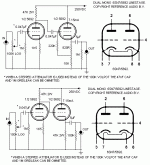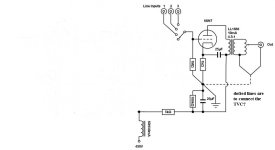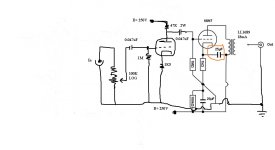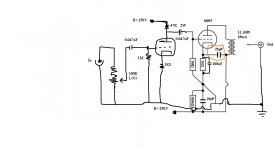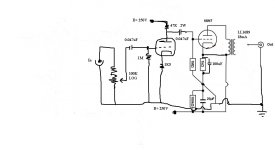Hi!
If your headphone has 300 Ohms impedance, you want to drive it with a lower Zout. I would consider 100 Ohms as minimum, preferably lower. That cannot be reached with a 6SN7 into a LL1660 4.5:1, even with both halves paralleled
Thomas
If your headphone has 300 Ohms impedance, you want to drive it with a lower Zout. I would consider 100 Ohms as minimum, preferably lower. That cannot be reached with a 6SN7 into a LL1660 4.5:1, even with both halves paralleled
Thomas
Thanks for the advice Thomas, could you recommend me some nice tube heaphone for my Sennhs HD600?
Hi!
A higher step down ratio transfromer should do it also with 6SN7, for example the Lundahl LL1689 which offers 9:1 and even 18:1 ratios. That would bring the Zout with paralleled 6SN7 down to about 60-70 Ohms including the copper losses of the transformer.
Thomas
A higher step down ratio transfromer should do it also with 6SN7, for example the Lundahl LL1689 which offers 9:1 and even 18:1 ratios. That would bring the Zout with paralleled 6SN7 down to about 60-70 Ohms including the copper losses of the transformer.
Thomas
Hi!
A higher step down ratio transfromer should do it also with 6SN7, for example the Lundahl LL1689 which offers 9:1 and even 18:1 ratios. That would bring the Zout with paralleled 6SN7 down to about 60-70 Ohms including the copper losses of the transformer.
Thomas
Using the same posted schematic?
Hi!
The schematic you posted shows a cathode follower. So you need to adapt it for use with such a transformer. Gain would be different compared to the schematic you posted. If you use a similar 2 stage approach with the last stage changed to transformer coupled, you will have about 6dB more gain with a 9:1 step down. The cathode follower is unity gain, a 6SN7 transfomer coupled with 9:1 has again of approx 2 (2 divided by 9 and then with some losses) which equates to about 6dB difference
Thomas
Thomas
The schematic you posted shows a cathode follower. So you need to adapt it for use with such a transformer. Gain would be different compared to the schematic you posted. If you use a similar 2 stage approach with the last stage changed to transformer coupled, you will have about 6dB more gain with a 9:1 step down. The cathode follower is unity gain, a 6SN7 transfomer coupled with 9:1 has again of approx 2 (2 divided by 9 and then with some losses) which equates to about 6dB difference
Thomas
Thomas
Hi Thomas,
As you know I'm a newbie, could you drive a schematic or link me to a schematic?
Thanks
Felipe
As you know I'm a newbie, could you drive a schematic or link me to a schematic?
Thanks
Felipe
Hi Felipe,
there are plenty schematics of transformer coupled stages for example in the 26 thread.
In my Octal preamp I use a transformer coupled 6SN7 in the linestage, with ultrapath cap:
VinylSavor: 6SN7
Best regards
Thomas
there are plenty schematics of transformer coupled stages for example in the 26 thread.
In my Octal preamp I use a transformer coupled 6SN7 in the linestage, with ultrapath cap:
VinylSavor: 6SN7
Best regards
Thomas
Hi!
I thought you wanted to modify the schematic of your opening post and adapt it for transformer out? That would mean keep the first stage and replace the cathode ollower with the transformer stage.
You need to check if gain is ok for you. Using both stages you will have more gain than with the cathode follower. Using just the transfomer stage it will be significantly less.
The dropping resistor is not needed it is only used in my preamp since I need higer voltage for thephono section. The 250V in the original schematic would work
You can implement any suitable power supply. If you need the choke depends on your power supply implementation.
Also keep in mind the 1660 will not be a good choice to drive a 300 Ohm headphone.
At a certain point you need to just build something then check what comes out and adapt.
Best regards
Thomas
I thought you wanted to modify the schematic of your opening post and adapt it for transformer out? That would mean keep the first stage and replace the cathode ollower with the transformer stage.
You need to check if gain is ok for you. Using both stages you will have more gain than with the cathode follower. Using just the transfomer stage it will be significantly less.
The dropping resistor is not needed it is only used in my preamp since I need higer voltage for thephono section. The 250V in the original schematic would work
You can implement any suitable power supply. If you need the choke depends on your power supply implementation.
Also keep in mind the 1660 will not be a good choice to drive a 300 Ohm headphone.
At a certain point you need to just build something then check what comes out and adapt.
Best regards
Thomas
Hi!
Please read post #4 in this thread ;-)
Thomas
Wich OPT do you recommend for 300 ohms headphone amp?
Please read post #4 in this thread ;-)
Thomas
Yes like that. The ultrapath cap from B+ to cathode of the second 6SN7 works best if B+ of that stage is decoupled e.g. by a choke. You can also use the conventional approach andleave that cap ou, instead apply a bypass cap to the 1k cathode resisor, say 100uF For a newbie maybe the better approach.
Thomas
Thomas
Correct. To start I suggest to emov the ultrapath cap und use the bypass instead. You might need to add some decoupling for the first stage, say 5k and it's own 25uF( or thereabout) cap. Or, if you want to keep it common, increase the last B+ cap. Up to maybe 100uF
Thomas
Thomas
- Status
- Not open for further replies.
- Home
- Amplifiers
- Tubes / Valves
- Lundahl LL1660 OPT Franks 6SN7 linestage
